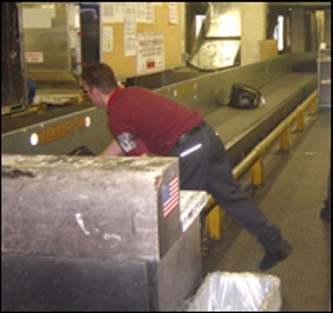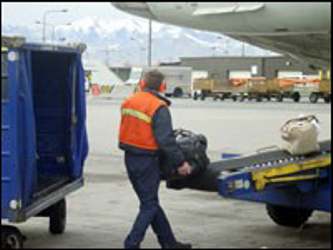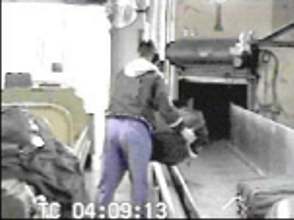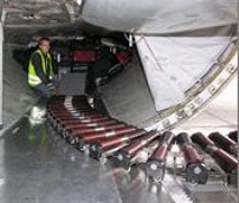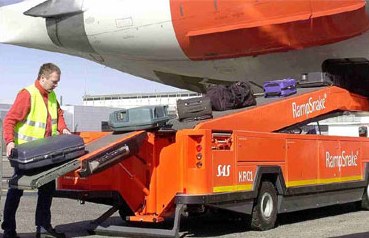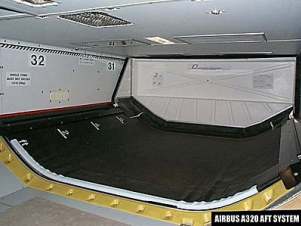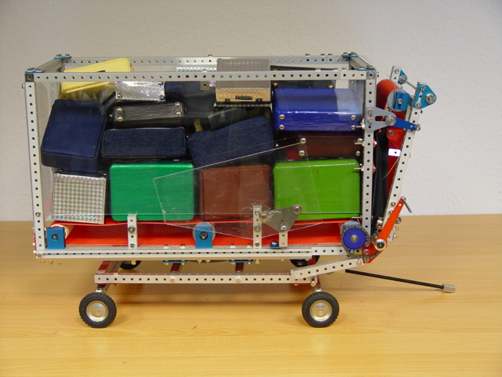|
|
|
THE "ZERO-G-LOADER"-PROJECT AS AN INNOVATIVE SOLUTION FOR AIRPORT BAGGAGE HANDLING ON THE APRON Tobias Erxleben, Lars Sallwey ABSTRACT Baggage handling systems differ strongly between the high developed transports systems inside of the terminal and those on the apron, where it is moved by hand, if it is not transported in ULD and that causes high injury risks for the involved staff. The attempt of the "Zero-G-Loader" is the automation of unloading bulky baggage and thereby acceleration of the process is achieved.
INTRODUCTION AND DEPICTION OF THE NECESSARY OPTIMIZATION IN THE LOGISTIC PROCESS The handling of baggage is an awkward point in discussions about employment protection. A series of statistics face the high injury risks for ramp agents in connection with the handling of bulky baggage on the apron. The analyzed interfaces are the loading of dollies in the make-up room, the loading and unloading of them in front of the aircraft and the unloading at the terminal in order to return the baggage to the passengers. The following pictures show the work in the mentioned areas.
It is remarkable how the employees move the heavy baggage in partly hazardous positions. It is necessary to twist and bend forward the upper part of the body to move the baggage, which has a weight between 15 and 45 kilogram at the maximum. It is handled up to 2000 times a day by one person. The exposure for the staff is very high at present and it may rise in the future, because the growth of the aviation market will go on in the next years [IATA 2005]. Aside from some throwbacks caused for example by the terrorist attacks of 9/11 the growth was continuous in the past. Further remarkable is the disproportionately high growth of the low-cost-carrier market. Low-cost-carrier offer a major part of its seat capacities for a price below the average market price. The processes of those airlines are characterized by a high speed orientation often in combination with single occupancy on each function, which causes an additionally high exposure for the staff. PRESENT SOLUTIONS FOR AN ERGONOMIC AND AUTOMATED BAGGAGE HANDLING RESPECTIVELY There are already airport technologies that speed up the process of baggage handling, make it more economic or safe. The foldover of baggage into the dollies or ULDs (Unit Load Device) in the make-up room may be done by robots in the near future. The development of those robots by different companies is highly sophisticated at present. The solutions are more or less feasible for the series launch and differ most in the design of their baggage grabbing part. Already used are products like Power Stow, Sliding Carpet or Ramp Snake, which speed up the loading and unloading of the aircraft and make the process in the baggage compartment more ergonomic. The functional principle of these products is a roller or belt conveyor respectively that moves the baggage in and out of the baggage compartment.
However the unloading of bulky baggage of the dollies is not or partly improved by these solutions. There are no standard products for the unloading of the baggage at the terminal in order to return it to the passengers. The Grenzebach Onero GmbH has developed a prototype for the unloading of baggage at the terminal. The dollies are cleared by a tilting mechanism. The Projektlogistik GmbH developed a solution covering and improving both interfaces of the process. THE "ZERO-G-LOADER" AS A FURTHER MODULE FOR AN OPTIMAL PROCESS The "Zero-G-Loader" concept is a solution for the unloading of bulky baggage in front of the aircraft and at the terminal. It substitutes the so far used dollies and can be implemented in the airport operations without the need to change the process or to rebuild parts of the airport buildings. It was the intention of the "Zero-G-Loader" to make the handling of baggage more ergonomic in combination with minimal costs. Hence it follows that the components of the construction are function-oriented and robust. The main problem of an automated unloading is to loosen the baggage getting caught during the transport over the apron and move it to a small conveyor belt without the risk of baggage hold-up. The basic principle of the "Zero-G-Loader" is based on a combination of transport technology that is already used as a standard at airports. The baggage compartment of the cart turns its small side towards the belt loader in order to reduce the difference between both conveyors (currently used dollies are two times longer then wide). Those turntables are already used for trailers that transport ULDs. The "Zero-G-Loader"-train is moved to the aircraft by a tractor and the baggage compartment is manually turned towards the belt loader. Baggage gets out of the cart by a conveyor that covers the whole bottom of the baggage compartment of the cart. For moving the baggage from the baggage compartment of the cart to the conveyor of the belt loader or the terminal, the "Zero-G-Loader" has a module consisting of a conveyor belt and scrapers on the side. This module has to be opened after turning the baggage compartment in order to form a bridge between the "Zero-G-Loader" and the belt loader. The conveyors of the baggage compartment and the module are powered by one crank which can be turned manually or by an engine, however the manually option is economically better. The baggage is moved slowly out of the baggage compartment and thereby it is separated by stretching out the baggage flow. The conveyor belt in the baggage compartment is moving slower than the one of the module, which moves slower than the conveyor of the belt loader again. When the baggage compartment is empty, the module has to be flipped up and thereby the baggage compartment is closed. The baggage compartment is turned to the starting position and the next "Zero-G-Loader" is prepared for unloading its baggage. The tractor pulls the train of carts forward, till the next "Zero-G-Loader" has the right position in front of the belt-loader. In addition to the unloading of baggage in front of the aircraft, the "Zero-G-Loader" is used for its unloading at the terminal. At this position the module is opened too and the bag-gage compartment has to be turned. The main difference between both interfaces of the process is the direction of conveyance. The conveyor at the terminal moves across the grain of the conveyor inside the baggage compartment. The clearing is speeded up in comparison to the actual process, because the baggage carrying system is designed for a big volume flow. Speeding up the process is not or only partly possible in front of the aircraft, because the ramp agent inside the aircraft is the bottleneck. In order to test and optimize the functional principle of the "Zero-G-Loader", before constructing a prototype, a model on a scale of 1:5 was built.
In addition to the model of the "Zero-G-Loader" it was necessary to imitate the baggage in order to verify the results of the experiment. Miniature baggage pieces have been made, which relate to the original ones in the size, weight, surface property and form stability. Additional components like straps and handles are necessary to simulate the hold-up risk. The test results approve the functional principles of the "Zero-G-Loader" and help to optimize the construction in order to build a prototype. SUMMARY The exposure for the staff during the unloading of the dollies in front of the aircraft as well as at the terminal is strongly reduced, because the hazardous positions by moving the baggage are substituted by turning a crank in an ergonomic way or an engine respectively. At the same time the process is accelerated, which causes a reduction of costs. The simple technical construction in combination with components that need low maintenance make the "Zero-G-Loader" inexpensive and allows a fast amortization towards the actual used vehicles on the apron. In the course of future requirements resulting from trends in the aviation sector that will mainly be affected by cost pressure, higher safety requirements and new types of aircrafts, the "Zero-G-Loader" is an outstanding alternative or addition referring to existing material flow solutions. The chances resulting from the approach are recognized by the Projektlogistik GmbH from Brandenburg and the development is supported by the European Fund for Regional Development and the Ministry of Economic Affairs Brandenburg. REFERENCES FMC Technologies, Inc., RampSnake, http://www.fmctechnologies.com/upload/rampsnake2.jpg, 09/2007 IATA (International Air Transport Association), 2005, Passenger and Freight Forecast Publications. OSHA (Occupational Safety & Health Administration), 2007, "make-up room" and "ramp area", http://www.osha.gov/SLTC/etools/baggagehandling/index.html, 09/2007. POWERSTOW A/S, 2007, About Power Stow, http://www.powerstow.com/about/about.html, 09/2007. TELAIR International GmbH, Narrow-Body Systems, http://www.telair.com/narrowBody_sliding Carpet.html, 09/2007. PROJEKT "ZERO-G-LOADER" JAKO INOWACYJNE ROZWIĄZANIE OBSŁUGI BAGAŻU NA PŁYCIE LOTNISKOWEJ
STRESZCZENIE
Pomiędzy zaawansowanymi technologicznie systemami obsługi bagażu wewnątrz terminalu lotniczego a ręcznym przeładunkiem na płycie lotniska występują istotne różnice. Jeżeli bagaż na płycie lotniska nie jest przewożony w pojemnikach, to pracownicy obsługi naziemnej są narażeni na wypadki. Celem projektu "Zero-G-Loader" jest próba automatyzacji rozładunku bagażu i dzięki temu przyspieszenie całego procesu
"ZERO-G-LOADER" PROJEKT ALS EINE INNOVATIVE LŐSUNG VON GEPÄCKABFERTIGUNG AUF DEM VORFELD
ZUSAMMENFASSUNG. Der Gepäckumschlag auf Flughäfen unterscheidet sich zwischen den hoch entwickelten terminalinternen Transportsystemen und dem Umschlag auf dem Vorfeld deutlich. Vorfeldseitig wird das Gepäck, sofern es nicht in Containern transportiert wird, manuell umgeschlagen, wodurch ein hohes Verletzungsrisiko bei den beteiligten Mitarbeitern entsteht. Der "Zero-G-Loader" verfolgt den Ansatz einer automatisierten Entladung von losem Gepäck und beschleunigt dabei gleichzeitig den Gesamtprozess.
mgr inż. Dipl.-Wirtsch.-Ing. (FH) Tobias Erxleben |
Copyright © 2005 LogForum, Wyższa Szkoła Logistyki, ul.E.Estkowskiego 6, tel. 061 852 95 55, 851 06 04, tel./fax. 061 851 06 03 |

